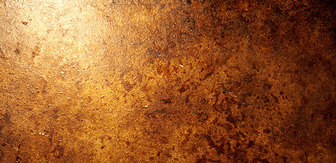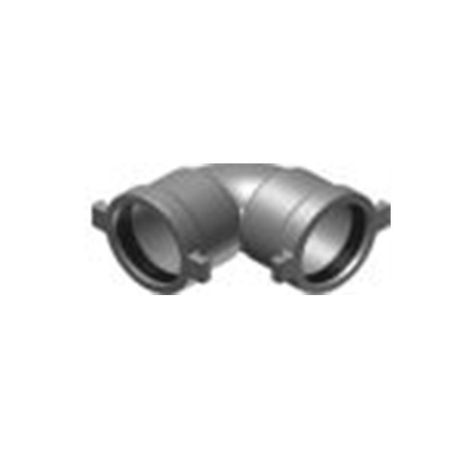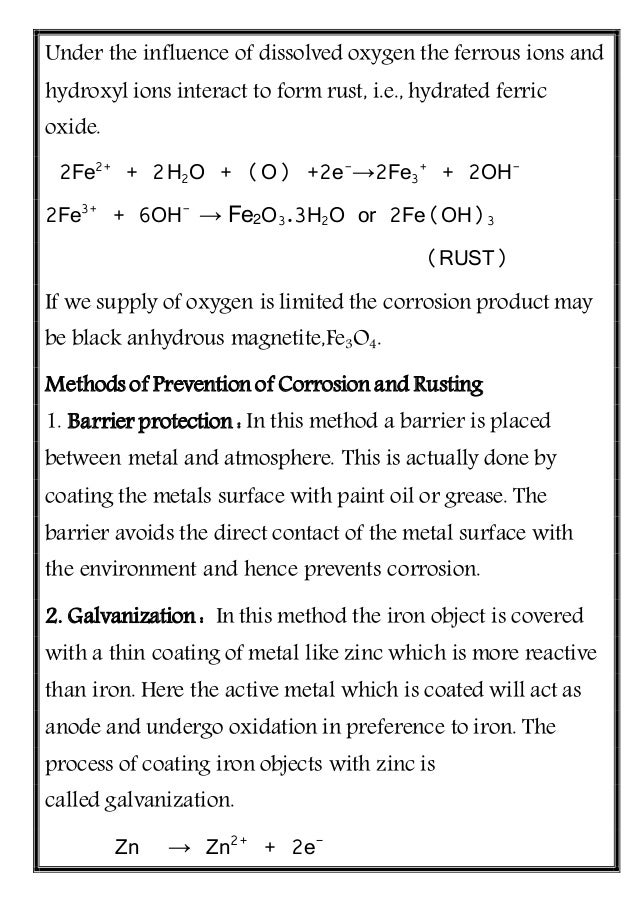Effect of metal coupling on rusting of iron pdf
Effect of metal coupling on rusting of iron pdf
ICBSE: Study of the Effect of Metal Coupling on the Rusting of Iron About the Author Cara Batema is a musician, teacher and writer who specializes in early childhood, special needs and psychology.
If you mean by coupling to use two different kinds of metal in close contact in a place where there is a lot of moisture in the air, there can be an electrolytic chemical reaction between the two different metals with corrosion resulting which wil…
Rusting of Iron Project . Rust is another name for iron oxide, usually red or black, which occurs when iron or an alloy that contains metal presented to oxygen and moisture for an extended period.
devices are made of a metal alloy (Table I), and for most of us, any concerns about corrosion implications from these implants are secondary to the relief we feel from the anticipated beneficial effect these devices are designed to have. As the global population increases in age, there is a parallel increase in the number of implantation procedures. One study reports that world-wide sales of
it includes aim, introduction, theory, procedure, observation, conclusion, prevention etc…..
Metals contain thermodynamic energy—positive and negative charges—that is released by the process of corrosion. Metals are rated in their ability to resist electrochemical corrosion on the scale of nobility and on the galvanic series chart, which shows their electrical potential in seawater.
Chemistry investigatory project on Effect of Metal Coupling on Corrosion 1. 1. Acknowledgement Certificate Introduction Resistance to corrosion Aim Materials Required Theory Procedure Observations Conclusions Precautions Protection from corrosion Biblography 2.
The Effects of Metal Couplings on the Rusting of Iron. Can Softened Water Cause a Copper Pipe to Corrode? The Effects of Saltwater on Metals. How Does Salt Water Rust Metals? About the Author. Writing professionally since 2010, Amy Rodriguez cultivates successful cacti, succulents, bulbs, carnivorous plants and orchids at home. With an electronics degree and more than 10 years of …
magnesium or aluminium rusting is prevented but if on the other hand . it is coupled with less electro – positive metals like copper .Aim of the project In this project the aim is to investigate effect of the metals coupling on the rusting of iron. 6 . the rusting is facilitated. Metal coupling affects the rusting of iron . If the nail is coupled with a more electropositive metal like zinc.
Traditionally, many firewater mains were made of carbon steel or cast iron. At present, more and At present, more and more stainless steel is used as material for …
How Metallic Coatings Protect Steel (Return to feature) Steel is a very versatile product. It comes in many sizes and types, and is applied to many end uses, including steel buildings, automotive panels, signs, and appliances.
Corrosion Concepts This section is not meant to be a detailed review of corrosion principles, rather it will briefly present corrosion terms that are common convention in the field of corrosion science and engineering. For details on corrosion principles the reader is directed to Fontana’ and H. H. Uhlig2 Corrosion is an electrochemical process that results in the degradation of a metal or
The effects of oxidation differ based on the metal involved, thus typically different terms are used to denote the differing effects: rust, tarnish, and patina. ( Ankersmit et al. 2013 ) In this context, rust is used to solely describe the reddish coating produced by the oxidation of iron and iron alloys.
The corrosion process is usually electrochemical in nature, having the essential features of a battery. Corrosion is a natural process that commonly occurs because unstable materials, such as refined metals want to return to a more stable compound.
Rusting is a common term for corrosion. Corrosion affects the surface of a metal by oxidizing the metal and converting it into corrosion product (rust). Some corrosion products are stable and protective, like the green patina that forms on copper, or the film that makes stainless steel “stainless”. Some corrosion products are not protective and the metal will continue to corrode. How the
Effects of Rust on Stainless Steel Surfaces On surfaces that are constantly wetted by mildly corrosive media, corrosion in the form of pitting can occur under “free iron” deposits which have oxidized.
red stains appear in iron or steel plumbing . systems or blue-green stains in copper and brass plumbing systems (Fig. 1). • Deep pits appear that can penetrate pipe or tank walls. This type of corrosion may not . add significant amounts of iron or copper to the water, but can eventually perforate a pipe or tank, and cause potentially major water damage to a home or business (Fig. 2
CR-042To study the effect of metal coupling on rusting

Corrosion of Embedded Material Other Than Reinforcing Steel
UL AND NEC REQUIREMENTS FOR CORROSION PROTECTION OF STEEL CONDUIT AND ELECTRICAL METALLIC TUBING When selecting a wiring method, life expectancy is one of the key issues typically considered. Depending upon the installation, part of that consideration concerns the resistance of the product to corrosive environments. All materials will eventually experience some corrosion, since corrosion …
Metal coupling effects the rusting of iron. If the nail is coupled with a more electro-positive metal like zinc, magnesium or aluminium, rusting can be prevented but on the other hand if it is coupled with a less electro-positive metals like copper, rusting is facilitated.
This ‘rusting’ corrosion can be prevented by connecting iron to a more reactive metal (e.g. zinc on iron or magnesium on steel). This is referred to as sacrificial protection or sacrificial corrosion , because the more reactive protecting metal is preferentially oxidised away, leaving the protected metal …
Experiment on effect of metal coupling on rusting of iron Get the answers you need, now!
After a certain time of immersion, the metal samples were removed, washed, dried and reweighed. The weight losses were used to calculate the rates of corrosion in kg/yr. From the corrosion rates, it was concluded that generally, the rate of corrosion of metals increases with decreasing pH.
The effect of pH and chloride concentration on the corrosion rate of wrought iron and cast iron was assessed using the SoftCorr TM II program and a EG&G model potentiostat VersaStat (model 253) potentiostat using a
2 C ONTACT WITH OTHER METALLIC MATERIALS 1 Introduction Complex design requirements can make it necessary to combine different metallic materials within the same component.
metals (iron and zinc) usually present because of corrosion can cause water to have a metallic taste. Laboratories and publications may report concentrations using units of milligrams/liter (mg/L) or parts per

i. C B S E . c o m IADEX 1. CertiIicate 2. Acknowledgement 3. Objective 4. Introduction 5. Materials and equipments 6. Procedure i C
24/01/2008 · Best Answer: The use of a more reactive metal to prevent oxidation of Iron depends upon the relative electromotive force of the oxidation reactions. Extremely electropositive metals (like Lithium, Sodium and Potassium) are not used because they will even react with …
Metal coupling affects the rusting of iron. If the nail is coupled with a more electro-positive metal like zinc, magnesium or aluminium rusting is prevented but if on the other hand, it is coupled with less electro –positive metals like copper, the rusting is facilitated.
Every metal has the natural tendency to revert back to its original mineral [form, and the more lightly processed finished metal, the more easily the reversion phenomena occurs [3] . Corrosion of steel or metal is an electro-chemical reaction between the metal and its environment in which the metal revert to iron oxide. The electro-chemical process causes a gradual alteration or wearing away
The effect of metal salts on the oxidation reaction of (acetylphenyl) ferrocenes To discuss the influence of the metal salts on the oxidation reaction, the oxidation reactions of (acetyl phenyl)ferrocenes and phenylferrocene were carried out.
This theory suggests that corrosion of a metal (iron) is due to the presence of acids surrounding it. According to this According to this theory, iron is corroded by atmospheric carbon di- …
If a metal sufficiently high on the activity series, such as iron, is electrically coupled to a region in contact with dissolved oxygen, the metal will undergo oxidation (i.e., it will corrode). For the case of iron, the oxidation reaction is

17/06/2009 · Best Answer: Iron and steel can be protected from rusting when coupled with a metal such as zinc or magnesium that corrode more easily (they are sacrificial anodes). For this reason steel may be coated with zinc as in galvanized metal which will exhibit little rusting while the zinc lasts.
project on rusting of iron 2 DECLARATION I hereby declare the project titled Experiment- effect of metal coupling on rusting of iron has been prepared, is the evidence of the Chemistry.Rust is an iron oxide, usually red oxide formed by the redox reaction of iron and oxygen in …
Galvanic corrosion (also called bimetallic corrosion) is an electrochemical process in which one metal corrodes preferentially when it is in electrical contact with another, in the presence of an electrolyte.
Effect of Metal Coupling on the Rusting of Iron – Download as Word Doc (.doc), PDF File (.pdf), Text File (.txt) or read online. Scribd is the world’s largest social reading and publishing site. Search Search
rusting of iron . means when you put an iron object left open in moist air. the moist air come into contact with the iron article and a brown flaky layer of iron oxide is … formed on on the object.
physical nature of a metallic surface has a very marked effect upon the quality of any electroplated metal that may be used to protect it. The presence of grease, oil, corrosion products, dirt, or other
Chemistry investigatory project on Effect of Metal Coupling on Corrosion 1. Acknowledgement Certificate Introduction Resistance to corrosion Aim Materials Required Theory Procedure Observations Conclusions Precautions Protection from corrosion Biblography
Stress corrosion and stress corrosion cracking (SCC) of metals is an effect that occurs when both tensile stress and corrosion act on a metal simultaneously; if either stress or corrosion …
CORROSION OF EMBEDDED MATERIALS OTHER THAN REINFORCING STEEL HUBERT WOODS,l Personal Member, ASTM This paper presents a discussion of behavior of metals other than reinforcing
Brass to Iron Pipe Corrosion Prevention Sciencing
– 1 1 2 manual metal hole punch
Effect of Metal Coupling on the Rusting of Iron Rust
Project report on effect of metal coupling on the

What effect does metal coupling have on rusting of iron
June 2009 ELECTROCHEMISTRY CORROSION USNA

Effect of Ph Level on Corrosion Rate Essay 2036 Words
UL AND NEC REQUIREMENTS FOR CORROSION PROTECTION OF


Corrosion Properties nde-ed.org
Study of effect of metal coupling on the rusting of iron
– CE336 09 Corrosion Rust Corrosion fr.scribd.com
Experiment on effect of metal coupling on rusting of iron


Corrosion Properties nde-ed.org
What effect does rusting have on metal surfaces? Quora
The corrosion process is usually electrochemical in nature, having the essential features of a battery. Corrosion is a natural process that commonly occurs because unstable materials, such as refined metals want to return to a more stable compound.
This theory suggests that corrosion of a metal (iron) is due to the presence of acids surrounding it. According to this According to this theory, iron is corroded by atmospheric carbon di- …
project on rusting of iron 2 DECLARATION I hereby declare the project titled Experiment- effect of metal coupling on rusting of iron has been prepared, is the evidence of the Chemistry.Rust is an iron oxide, usually red oxide formed by the redox reaction of iron and oxygen in …
The effect of pH and chloride concentration on the corrosion rate of wrought iron and cast iron was assessed using the SoftCorr TM II program and a EG&G model potentiostat VersaStat (model 253) potentiostat using a
devices are made of a metal alloy (Table I), and for most of us, any concerns about corrosion implications from these implants are secondary to the relief we feel from the anticipated beneficial effect these devices are designed to have. As the global population increases in age, there is a parallel increase in the number of implantation procedures. One study reports that world-wide sales of
Every metal has the natural tendency to revert back to its original mineral [form, and the more lightly processed finished metal, the more easily the reversion phenomena occurs [3] . Corrosion of steel or metal is an electro-chemical reaction between the metal and its environment in which the metal revert to iron oxide. The electro-chemical process causes a gradual alteration or wearing away

The effect of metal salts on the oxidation reaction of (acetylphenyl) ferrocenes To discuss the influence of the metal salts on the oxidation reaction, the oxidation reactions of (acetyl phenyl)ferrocenes and phenylferrocene were carried out.
UL AND NEC REQUIREMENTS FOR CORROSION PROTECTION OF